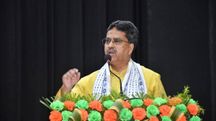Brothers beyond borders: Similarities between NorthEast India And South-East Asia
 NorthEast India
NorthEast IndiaGuwahati, April 21, 2019:
Southeast Asia or Southeastern Asia is a subregion of Asia, consisting of the countries that are geographically south of China and Japan, east of India, west of Papua New Guinea, and north of Australia.
Southeast Asia consists of two geographic regions:
Mainland Southeast Asia, also known historically as Indochina, comprising parts of Northeast India (Part of India east of Siliguri Corridor), Vietnam, Laos, Cambodia, Thailand, Myanmar, and West Malaysia, and Maritime Southeast Asia, also known historically as Nusantara, the East Indies and Malay Archipelago, comprises the Andaman and Nicobar Islands of India, Indonesia, East Malaysia, Singapore, the Philippines, East Timor, Brunei, Christmas Island, and the Cocos (Keeling) Islands. Taiwan is also included in this grouping by many anthropologists. (from Wikipedia)
The amalgamation of different cultures has led to many similarities which have turned the Southeast Asian countries and the NorthEast of India into one big whole.
The South East Asian countries have much in common with North-Eastern part of India. In terms of culture and heritage, both have similarities and are connected due to their common practices and closeness with each other.
The greatest mirror reflection in terms of culture is the festivals celebrated in these regions, especially in the month of April. The festival of Bohag Bihu in Assam, Pi Mai in Lao PDR, Songkran in Thailand and Sangkem in Arunachal Pradesh marked the beginning of a New Year and hold similar importance.
Pi Mai in Lao PDR is celebrated with people throwing of water on each other with dances and songs, with the worship of Lord Buddha. Sangkem in Arunachal too follows the custom of throwing water at each other and also follows the worship of Lord Buddha.
Songkrem in Thailand also signifies pouring of water by the younger people on elders hand as a sign of respect. They too worship Lord Buddha. Bohag Bihu in Assam marks the harvesting season of crops with dances and songs. Elders are paid respect by the youngsters by offering traditional scarves called ‘Gamusa’ and they seek their blessings.
Also, the language of the Tai people living in Arunachal Pradesh and Assam has similarities with the language spoken in Thailand and Lao PDR. Tai – Ahoms or Ahoms are called 'Shan' in Myanmar, 'Thai' in Thailand, 'Lao' in Laos, 'Dai' and ''Zhuang' in China and 'Tay – Thai' in Vietnam. Chin Kuki Mizo community too has similarities with the Chinese. Some of the Naga and Manipuri people of North-East India too have some connection with South-East Asia and may have migrated from South East Asia.
In relation to the dance form, Balinese dance and Manipuri dance forms have similar gestures and they don’t have direct eye contact. Regarding the attires, the yellow color robes among the Tais in Yunann is similar to the Meitei grooms of Manipur which they wear a day after the wedding. There are similarities between the food habits too as the sticky rice commonly consumed by the tribes of northeast India is like the sticky brown rice found in Japan and China.
Apart from meat and fish, vegetables too are common in China, Hong Kong, Singapore, Japan, and other South Asian countries. They all offer similar types of taste with a wide range of unique flavors and ingredients of fermented nature.
The markets in Myanmar are similar to the NorthEast where goods are stacked in the same way as the Northeast region and have similar products displayed. The Burmese dress is worn just the way it is in Northeast and street food and traditional food items also have similarities.
There are many common physical features in Art and Dance forms, social structure, eating habits, weaving motifs, hunting practices, and cultural practices between the South Asian Countries and Northeast India. Both regions share an intrinsic connection that dates back centuries. Apart from all these facts, Thailand is greatly indebted to India for spreading of Buddhism by a Buddhist monk sent by King Ashoka in 3rd century BC.
It was adopted as the state religion of Thailand. During this era, the Thais adopted Indian religious and cultural traditions. The Indians who moved into Thailand in the Sukhothai period (1275-1350) were either merchants or Brahmans who played an important role in the Siamese court. According to Thai people, the King is the reincarnation of the Hindu Deity Lord Vishnu from Indian traditions.
The dramas of Thailand are inspired by the Hindu epic Ramayana. Thai language too is similar to Dravidian language. Several Thai ceremonies were adopted from Indian tradition. Astrology’s of India have a great Impact on the Thai People.
For many rituals, they seek advice from the Buddhist monks or Brahmans for auspicious days to conduct or hold those ceremonies. Thai people also make herbal medicines like the people of India. 98 % of the North-eastern states also share their borders with some of India’s South Asian neighbors such as China, Myanmar, Thailand, Bangladesh, etc.
Copyright©2026 Living Media India Limited. For reprint rights: Syndications Today









